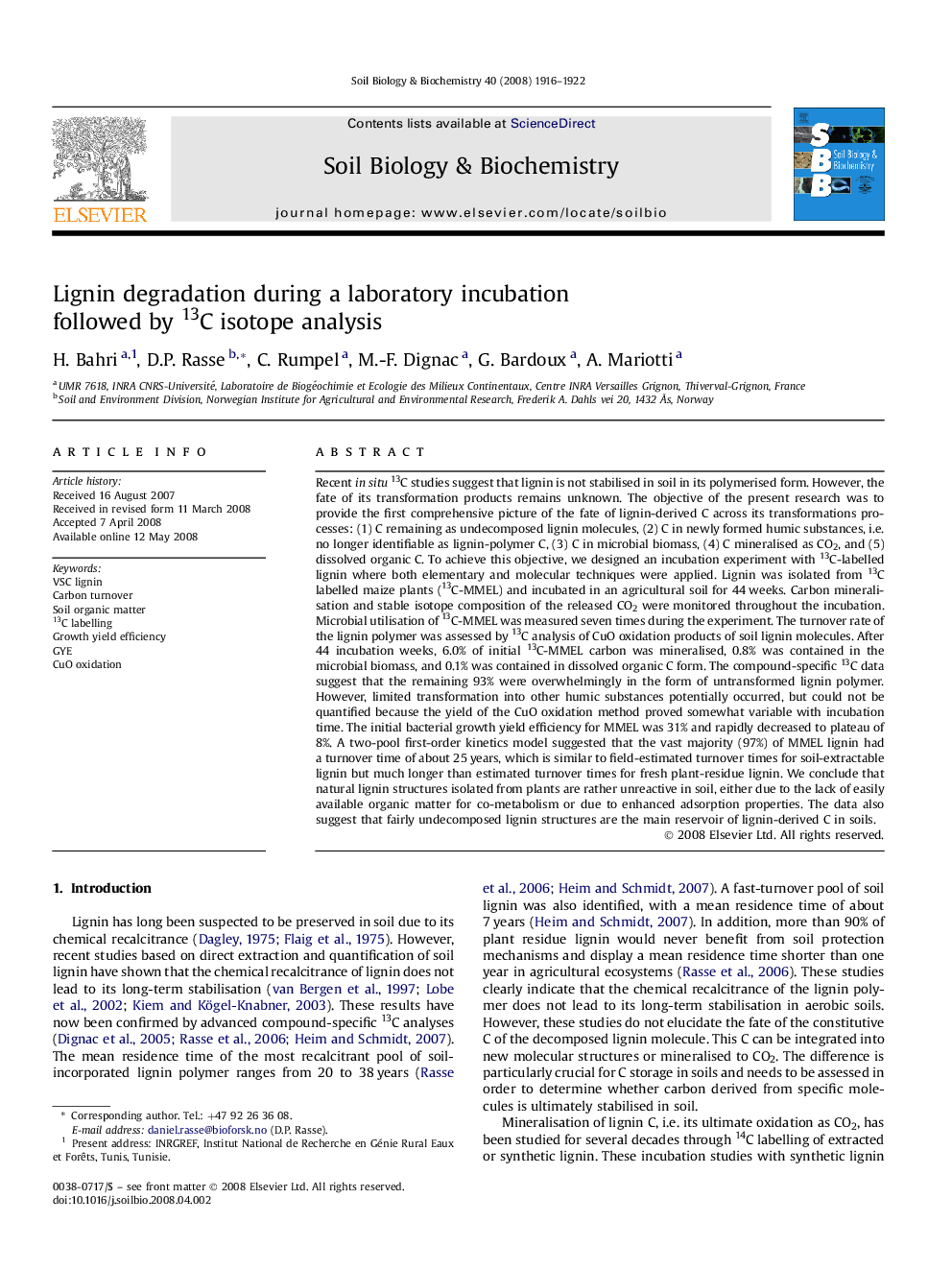| کد مقاله | کد نشریه | سال انتشار | مقاله انگلیسی | نسخه تمام متن |
|---|---|---|---|---|
| 2025847 | 1070011 | 2008 | 7 صفحه PDF | دانلود رایگان |
عنوان انگلیسی مقاله ISI
Lignin degradation during a laboratory incubation followed by 13C isotope analysis
دانلود مقاله + سفارش ترجمه
دانلود مقاله ISI انگلیسی
رایگان برای ایرانیان
کلمات کلیدی
موضوعات مرتبط
علوم زیستی و بیوفناوری
علوم کشاورزی و بیولوژیک
دانش خاک شناسی
پیش نمایش صفحه اول مقاله

چکیده انگلیسی
Recent in situ 13C studies suggest that lignin is not stabilised in soil in its polymerised form. However, the fate of its transformation products remains unknown. The objective of the present research was to provide the first comprehensive picture of the fate of lignin-derived C across its transformations processes: (1) C remaining as undecomposed lignin molecules, (2) C in newly formed humic substances, i.e. no longer identifiable as lignin-polymer C, (3) C in microbial biomass, (4) C mineralised as CO2, and (5) dissolved organic C. To achieve this objective, we designed an incubation experiment with 13C-labelled lignin where both elementary and molecular techniques were applied. Lignin was isolated from 13C labelled maize plants (13C-MMEL) and incubated in an agricultural soil for 44Â weeks. Carbon mineralisation and stable isotope composition of the released CO2 were monitored throughout the incubation. Microbial utilisation of 13C-MMEL was measured seven times during the experiment. The turnover rate of the lignin polymer was assessed by 13C analysis of CuO oxidation products of soil lignin molecules. After 44 incubation weeks, 6.0% of initial 13C-MMEL carbon was mineralised, 0.8% was contained in the microbial biomass, and 0.1% was contained in dissolved organic C form. The compound-specific 13C data suggest that the remaining 93% were overwhelmingly in the form of untransformed lignin polymer. However, limited transformation into other humic substances potentially occurred, but could not be quantified because the yield of the CuO oxidation method proved somewhat variable with incubation time. The initial bacterial growth yield efficiency for MMEL was 31% and rapidly decreased to plateau of 8%. A two-pool first-order kinetics model suggested that the vast majority (97%) of MMEL lignin had a turnover time of about 25Â years, which is similar to field-estimated turnover times for soil-extractable lignin but much longer than estimated turnover times for fresh plant-residue lignin. We conclude that natural lignin structures isolated from plants are rather unreactive in soil, either due to the lack of easily available organic matter for co-metabolism or due to enhanced adsorption properties. The data also suggest that fairly undecomposed lignin structures are the main reservoir of lignin-derived C in soils.
ناشر
Database: Elsevier - ScienceDirect (ساینس دایرکت)
Journal: Soil Biology and Biochemistry - Volume 40, Issue 7, July 2008, Pages 1916-1922
Journal: Soil Biology and Biochemistry - Volume 40, Issue 7, July 2008, Pages 1916-1922
نویسندگان
H. Bahri, D.P. Rasse, C. Rumpel, M.-F. Dignac, G. Bardoux, A. Mariotti,